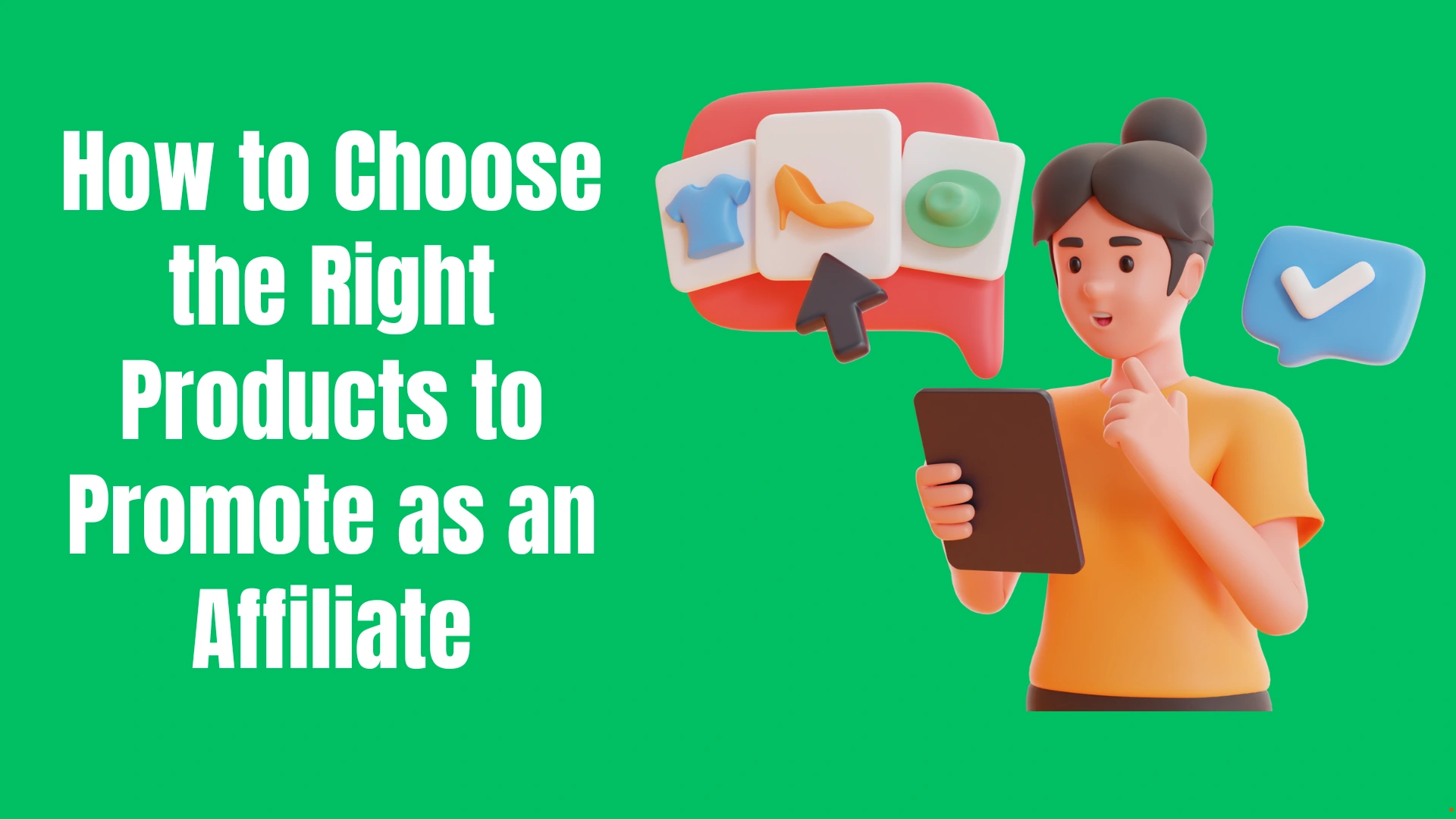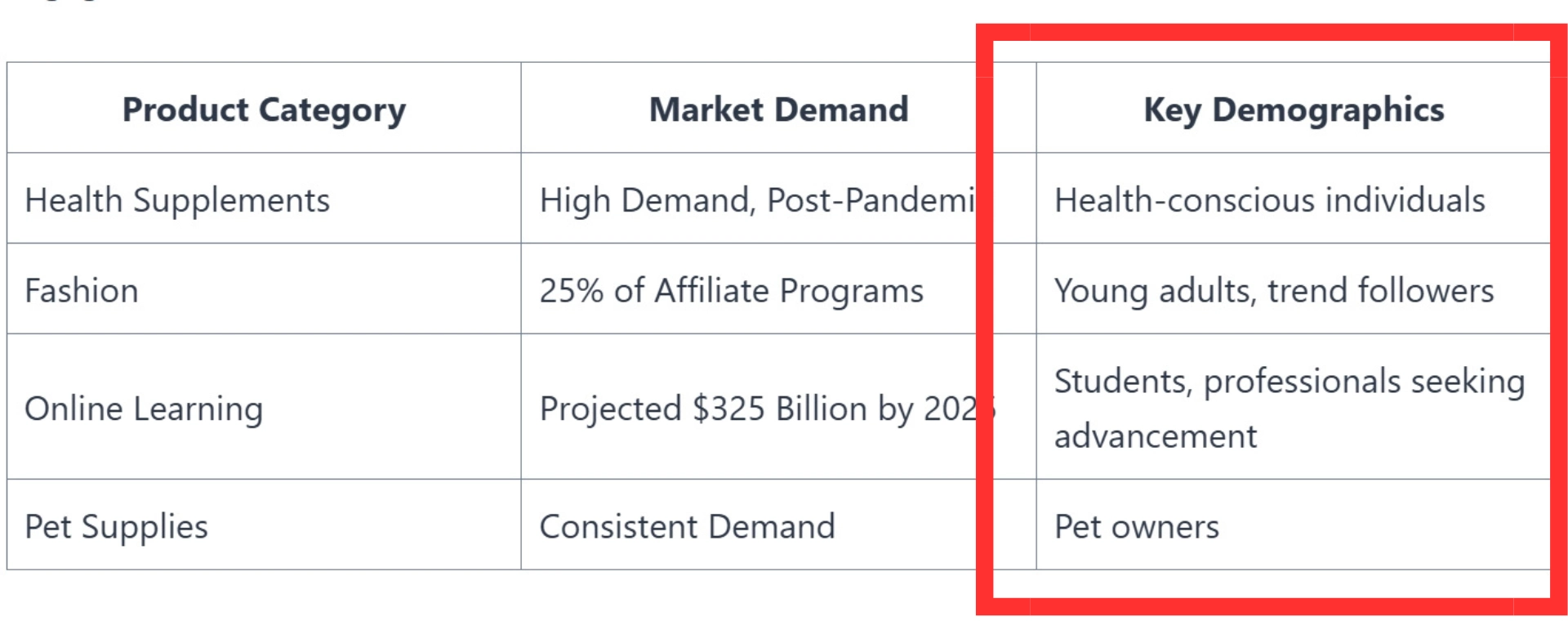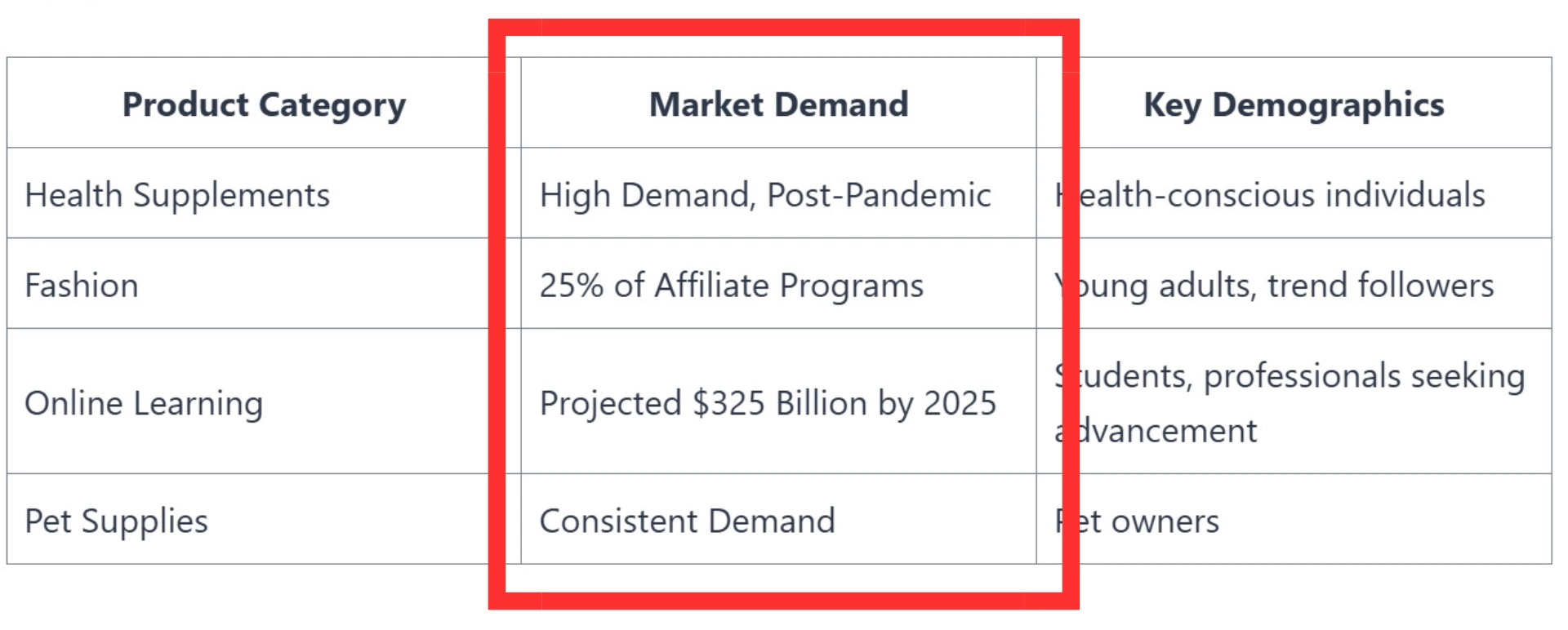How to Choose the Right Products to Promote as an Affiliate

Choosing the right products to promote as an affiliate isn’t just about picking what looks good. If you promote something people don’t want, you won’t make sales. The best products match your audience’s interests, solve real problems, and come from brands people trust.
If you get this right, commissions will follow. And If you get it wrong, you’ll waste time pushing products that no one buys.
I made this mistake early on. I picked products I liked but never thought about what my audience needed. The results were scary; no clicks, and no sales. Once I switched to products that actually helped my audience, everything changed. People started engaging more, and my commissions grew. So, choosing wisely is very important and also makes the difference between success and failure.
Trust is everything in affiliate marketing. If you promote junk, people won’t believe you next time. The best affiliates only recommend things they’d use themselves. When you believe in what you promote, your audience will too. That’s how you build trust, grow your income, and make affiliate marketing work for you.
Now, Let’s dive into how to choose the right products.
Key Takeaways
- Understanding the affiliate marketing industry’s growth can shape your product selection strategies.
- Choosing the right products to promote aligns with your audience’s preferences.
- Researching affiliate programs is essential in identifying reputable and profitable options.
- Your success rests not just on product popularity but on relevance to your niche.
- Effective selection of products can lead to higher conversion rates and income.
The Importance of Product Selection in Affiliate Marketing
Choosing the right products to promote is key to success in affiliate marketing. The wrong choices can waste your time and hurt your earnings. Products that don’t match market demand or consumer interest can lead to lower profits.
It’s important to know your audience well when picking products. Understanding their needs and preferences helps you choose the right products. Tools like Google Trends can show you which products are in demand.
Exploring specific in-demand niches like finance or SaaS can open up new opportunities. For example, SaaS programs like GetResponse offer ongoing commissions. Financial products often have higher payouts because of their long-term value. The right product choice is even more crucial during economic shifts.
Choosing well-known brands can also boost your credibility. These brands usually have better conversion rates and customer loyalty. This makes it easier to keep your audience coming back. The potential earnings can vary a lot depending on the product. For instance, selling multiple BudgetFit steppers might not match the commission of one StepperZone item.
In the end, success in affiliate marketing depends on picking products that meet your audience’s needs. It’s about aligning with market trends, maximizing earnings, and building trust in your promotions.
How to Choose the Right Products to Promote as an Affiliate
As I have said, your success in affiliate marketing greatly depends on choosing the right products. If you promote the wrong ones, you’ll struggle to make sales. Pick wisely, and your audience will trust your recommendations and eventually buy from your links. Here’s how to choose products that work.
1. Pick Products That Fit Your Niche
Don’t just pick any product because it pays a good commission. Stick to products that make sense for your niche. If your content is about fitness, your audience expects recommendations related to health, workouts, or nutrition. Promoting kitchen blenders or pet supplies in this case won’t connect with them. Instead, focus on workout gear, supplements, or meal plans that fit their needs.
Staying relevant keeps your audience engaged and increases the chances of them buying through your links.
Before promoting anything, ask yourself: Would my audience actually use this? Is it helpful to them? does it solve their problem? A product might be great, but if your followers don’t care about it, it won’t sell.
The best affiliate products solve real problems. If your audience struggles with weight loss, a well-reviewed meal replacement shake could be a hit. If they need better home workouts, resistance bands or dumbbells might be the perfect fit. Always choose products that help, not just products that pay well.
Your brand also matters. If you’ve built a reputation as a no-nonsense fitness expert, suddenly promoting a random tech gadget will feel off. People follow you because they trust your recommendations.
Promoting the wrong things can make them lose faith in you. When you stick to products that match your niche and brand, your audience listens and more importantly, they buy.
2. Identify Your Target Audience
To succeed in affiliate marketing, you need to know your audience. Without understanding who you’re talking to, your promotions won’t connect. Start by asking: Who are they? What problems do they need solving? What are they interested in?

Use your blog, social media, or website to gather information. Look at the age, interests, and behaviors of people interacting with your content. Tools like Google Analytics and social media insights can show you what your audience likes and how they engage with your content.
Knowing your target helps you choose the right products to promote. If you’re running a tech blog, you should promote tech products. If you’re in fitness, focus on workout gear or health supplements. When you align your promotions with your audience’s needs and interests, you’ll build trust, increase engagement, and drive more sales.
3. Choose Products with Real Demand
A product might seem perfect, but if no one wants it, you won’t make sales. You need to pick products that people are already searching for and buying. It’s easier to sell something in demand than to convince people they need something new. The more people want a product, the better your chances of making commissions.

Start with analyzing data. Google Trends shows whether interest in a product is growing or fading. If searches are increasing, it’s a good sign. Amazon Best Sellers helps too; if something is ranking high with lots of positive reviews, means people are buying it. But don’t stop there. Go deeper. Check Reddit, Quora, and niche forums to see what real people are talking about.
Social media can also be a goldmine. What are influencers promoting? What are people raving about in the comments? These clues tell you what’s trending and worth your time.
Go for products people are actively looking for. Don’t waste time pushing something just because it sounds cool. If no one is searching for it, as I mentioned, you’ll struggle to make sales. Find products that solve problems, have a track record of success, and already have buyers waiting. That’s where the money is.
4. Promote Quality, Not Just High Commissions
A high commission sounds nice, but if the product is trash, it’s not worth it. Promoting low-quality products can ruin your credibility fast. People trust your recommendations, and if you steer them wrong, they won’t come back.
A quick sale isn’t worth damaging your reputation. Long-term success in affiliate marketing comes from trust, not just big payouts.
Before promoting anything, do your homework well. Check reviews on Amazon, Trustpilot, and other niche forums. If a product has poor ratings or tons of complaints, skip it. Look for products with high ratings and detailed positive feedback.
If buyers are happy, chances are your audience will be too. If possible, try it yourself. First-hand experience helps you give honest recommendations. If you wouldn’t spend your own money on it, don’t push it on others.
Selling junk might bring quick cash, but it won’t last. Happy customers come back, and they tell others. Build your brand by promoting things that help people. A great product sells itself, and your audience will trust you more for choosing wisely.
5. Check the Commission Structure
Not all affiliate programs pay the same. Some offer a cut of each sale, while others pay a flat fee per lead. Before jumping in, look closely at how you’ll get paid. A high commission sounds great, but if the product rarely sells, it won’t matter. A smaller commission on something people buy might earn you more in the long run.
Pay attention to cookie duration. This determines how long you get credit for a sale after someone clicks your link. Some programs give you 24 hours, while others last 30 days or more. Longer cookies mean more chances to earn.
Also, check if the program offers recurring commissions. Some products, like software subscriptions, pay you every month as long as the customer stays subscribed.
Take your time comparing different programs. A 5% commission on a hot-selling product can beat a 50% payout on something nobody buys. Pick programs that balance good payouts with real sales potential.
Must Read: Understanding the Affiliate Commission Structure: What It Is and How It Works
6. Consider Product Price and Conversion Rate
High-ticket products pay more per sale, but they can be tough to sell. Cheaper items move faster, but you’ll need a lot of sales to make real money. The key is finding that sweet spot, products that pay well and convert.
Mid-range products ($50–$200) often hit that balance. They’re not too expensive for impulse buys, yet they still bring in decent commissions.
Subscription-based products are another great option. They offer recurring commissions, meaning you get paid every month as long as the customer stays subscribed. That’s passive income without extra work.
Test different products and track what sells best. If your audience buys lower-priced items more often, focus on volume. If they’re open to premium products, go for those bigger commissions. The right mix depends on your niche and what your followers trust you to recommend.
7. Look for Trusted Brands and Reliable Affiliate Programs
People buy from brands they trust. If you promote low-quality or unknown brands, you risk refunds, complaints, and a damaged reputation. Sticking with trusted companies makes sales easier and keeps your audience coming back.
Big names like Amazon, eBay, and Shopify already have customer trust. Their return policies and support teams handle issues, so you don’t have to. Affiliate networks like ShareASale, CJ Affiliate, and Rakuten connect you with legit brands, helping you avoid scams or unreliable programs.
Before signing up, check reviews from other affiliates. Look for programs that pay on time, have fair terms, and don’t suddenly cut commissions. A good program isn’t just about high payouts but also long-term reliability.
Must Read: 8 Main Key Features of a Good Affiliate Program
8. Test, Track, and Adjust
Not every product will automatically sell well or perform as expected. The key to affiliate marketing success is constantly tracking, testing, and making adjustments. Some products may seem like a great fit but may not resonate with your audience. The only way to find what works is to consistently test different options and track how each performs.
Start by using Google Analytics to track where your website traffic is coming from and which pages are generating clicks. This can help you understand which products are attracting the most interest.
Additionally, affiliate programs often provide their own affiliate dashboards, where you can access detailed sales data, conversion rates, and other important metrics. These dashboards allow you to pinpoint which products are selling well and which are lagging behind.
To take your tracking further, tools like Pretty Links or Bitly allow you to track individual link clicks. By shortening your affiliate links and tracking them, you can see which ones are getting the most engagement and driving sales.
If a specific product or link isn’t converting well, it’s time to try a new approach. Don’t be afraid to test different products, change your promotional tactics, or even adjust the way you present the product. Continuous testing and adjusting is the secret to finding the right products and strategies that will generate the most income.
Key Considerations for Choosing Affiliate Products
Here is a summary of a few things to consider when choosing the appropriate product to promote:
- Choose products that fit your audience’s needs and align with your brand values.
- Research customer preferences before making decisions.
- Engage with your audience to understand what they truly want.
- Select products that offer real value for long-term satisfaction and repeat business.
- Continuously refine your strategy to keep up with changing trends and demands.
- Build your authority in your niche to gain trust and foster loyalty.
- Look for exclusive deals that give you an edge in the market.
Strategies for Effective Product Promotion
To succeed in affiliate marketing, you need to use proven strategies that resonate with your audience. Content that grabs attention is crucial, and blog posts with affiliate links work best when they’re fresh and relevant. This helps increase click rates and keeps your audience engaged.
Product reviews, comparisons, and guides are great tools for showing off products, as they provide solutions that meet your audience’s needs.
SEO plays a big role in boosting your affiliate marketing success. By using the right keywords, you can make your content more visible to potential customers. Research shows that 60% of shoppers search for deals before making a purchase and this is why SEO is very essential.
Adding exclusive discounts through affiliate links can greatly boost engagement and sales; whether you’re sharing them in blog posts, videos, or social media.
Social media is another powerful tool for affiliate marketing. With posts, videos, and stories featuring affiliate links, you can reach a wider audience.
Podcasts and webinars also offer excellent opportunities to connect with your followers and promote products, making it easier to drive traffic and sales.
| Content-Type | Engagement Potential | Recommended Use |
|---|---|---|
| Blog Posts | High | Product reviews, “how to” guides |
| Social Media | Very High | Engaging posts, stories |
| Video Marketing | Increasing | Product demonstrations, reviews |
| Podcasts/Webinars | High | Discussions, guest appearances |
Common Mistakes in Affiliate Product Selection
In affiliate marketing, avoiding mistakes is important for success. Picking the wrong products can harm your reputation and income. Here are two big mistakes: promoting high-commission items without considering fit, and focusing only on popular products.
Only Choosing Popular Products
The main mistake is picking only trendy products. While popular items seem like a safe bet, their popularity can fade fast. Some products see a 50% drop in sales after the initial hype fades. Choosing products based solely on trends can hurt long-term success. Instead, focus on what’s truly relevant to your audience. Using affiliate management tools can help avoid these mistakes and make smarter choices.
Chasing High Commissions Without Relevance
Many marketers focus on earning more by promoting high-commission products. But this can backfire if the products don’t match their audience. Studies show that 80% of affiliate marketers fail to pick products their audience wants, leading to lower engagement.
Instead, promoting products that fit your audience’s needs can boost conversions by up to 30%. It’s better to focus on relevance than just high payouts.
Conclusion
Choosing the right products to promote will help you achieve more in affiliate marketing. Start by picking products that fit your niche and align with your audience’s interests. Research demand, ensure quality, and check commission structures to find the best opportunities.
Remember, it’s not just about making quick sales; it’s about building trust with your audience. Focus on promoting products that offer value, come from trusted brands, and fit your audience’s needs. Keep testing and adjusting as you go, and always stay in tune with your audience’s preferences.
By following these steps, you’ll not only increase your chances of earning but also build a loyal audience that trusts your recommendations.
Frequently Asked Questions
How do I know which products to promote for my blog?
Choose products that align with your niche and match your audience’s needs. If you focus on fitness, promoting workout gear or supplements is better than unrelated items. The key is ensuring your audience finds value in what you recommend.
Why is researching product demand important?
Researching demand helps ensure you’re promoting products people are actually interested in buying. Use tools like Google Trends, Amazon Best Sellers, or social media platforms to see what’s trending and get a feel for what your audience wants.
What should I consider when choosing an affiliate program?
When selecting an affiliate program, consider commission rates, cookie duration, and whether it offers recurring payments. Also, make sure the product is something your audience will trust. A program that balances high quality with a fair payout is ideal.
How can I be sure a product is high quality?
To ensure quality, read customer reviews on sites like Amazon or Trustpilot. High ratings and positive feedback are good indicators. You can also test the product yourself or check its reputation within the industry to ensure it meets expectations.
How do I track my affiliate marketing success?
Tracking success is key to understanding what works. Use Google Analytics to monitor traffic sources, affiliate dashboards to see sales data, and link shorteners like Pretty Links to track clicks. Regular testing and adjustments help optimize your affiliate strategy.







Thank you for your sharing. I am worried that I lack creative ideas. It is your article that makes me full of hope. Thank you. But, I have a question, can you help me?